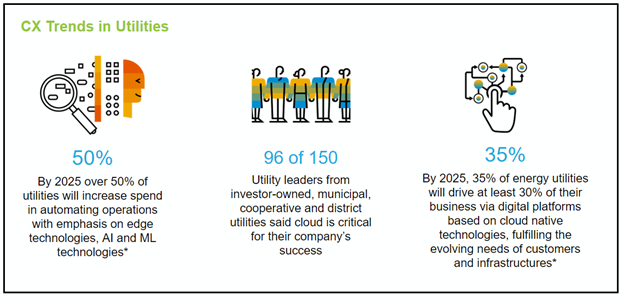
October 15, 2021
Achieving a Lower Total Cost of Ownership (TCO) for CIS
According to Gartner, SAP is the worldwide leading solution provider for utility customer information systems (CIS), as well as the leading CIS provider with the largest total number of installed clients. SAP has over 4,500 utility customers globally with over 1,200 Industry Solution for Utilities (IS-U) installations. In North America, SAP currently has over 136 utility CIS customers. The main reasons investor-owned and mid-sized utilities select SAP for their CIS operations, they say, are SAP’s unique ability to handle comprehensive customer segmentations, multi-jurisdictional regulatory challenges and complex billing rate requirements.
Gartner also recently reported that utilities are transitioning to a customer experience (CX) focus, where functional requirements related to CIS operations are becoming “everything customer” and “everywhere stakeholders.” IDC is predicting that in the near future over 50% of utilities will automate operations around edge technologies, artificial intelligence and machine learning; 64% of utility leaders feel cloud computing is critical for success; and 35% of energy utilities will drive one third of their business with digital platforms to achieve a better customer experience and significantly improve worker wellbeing and safety. The SAP IS-U solution enables the utility to implement a comprehensive CIS digital platform for that future, today.

Why leverage an integrated solution to optimize TCO?
For a typical, regulated utility there are three main areas (related to SAP solutions) that drive the TCO: ERP, EAM and CIS (including customer experience and AMI/Smart Metering). Out of those three, the CIS regularly contributes the largest share to the TCO – 50% if not 60% or more when AMI and smart meters are included. Due to its impact, we are using the CIS solution area as an example here.
Historically, CIS implementation costs range widely depending upon several variables that include timeline, availability and level of expertise associated with project resources, willingness to offshore some or most project resources, and software licensing models. Many flawed implementations are a result of trying to force the business processes of the legacy system into a new enterprise solution.
Leveraging a comprehensive, integrated business platform that simplifies end-to-end business processes derived from industry experience can de-risk implementations. It can help utilities avoid many other common implementation pitfalls. These pitfalls often result in “customizations” that increase the cost to implement, maintain and upgrade the solutions in the future. Another pitfall is using workarounds in the leading-practice processes within the solution, which diminish the efficiency or effectiveness of the business solution. The leading practice is a pre-configured approach that helps marry the business to the technology so both operate as they were designed, achieving efficiencies and driving value.
Utilities that use SAP solutions and follow this practice, regardless of market and region, achieve a lower TCO than the typical guidance provided for the industry, with a range of 3% - 5% of total IT spend as the typical Utilities Benchmark. The graphic here shows a sample of data points of the TCO ratio to revenue collected by SAP and reveals that SAP CIS customers consistently fall below the 3% - 5% range.

There are a number of factors that help to achieve such lower levels of TCO. For example, using a common platform reduces the number of skills and experts needed. And the fact that SAP solutions and technologies are utilized in tens of thousands of companies leads to very large pools of expertise, which reduces both risk and cost.
Another source for cost reduction is in the solution itself. The SAP solution for utilities is proven by hundreds of utilities globally and has been recognized as the market leader for many consecutive years. This wide and diverse customer base multiplied by many years of experience in all commodities, markets and regions ensures the solution provides an extensive coverage of utilities’ specific processes and their variants. Furthermore, the solution components are regularly integrated and prepared for industry-specific use cases, reducing the need for expensive customizations.
We are all evolving to pre-packaged solution sets. Whether a smart phone app or cloud-based enterprise technology, these solutions deliver speed, ease of use, acceptance, and a lower TCO. These “fit-for-purpose” processes allow us to do segments of work that make our life simpler. Utegration has incorporated these principles across a preconfigured, simpler, user-focused, lower-TCO utilities solution.
An SAP preconfigured solution balances all the key factors for success by mitigating common CIS implementation risks.
Implementations based on preconfigured SAP solutions typically are 30% - 50% below non-preconfigured solution projects for CIS installations. In particular, when the preconfigured solution covers not only CIS, but includes AMI, EAM and ERP business process areas as well. Some of the key reasons for the significant reductions are:
- Proven data conversion tools
- Seamless integration to 3rd party solutions
- Built-in content creation and training platform to foster rapid learning and adoption
There are benefits beyond implementation as well. With a preconfigured solution design, utilities gain predictable operations, business outcomes and maintenance costs.
And when the solution is built and delivered by solution architects and delivery teams with deep SAP CIS, AMI, EAM, ERP and utility integration expertise, you can be confident it has the capabilities and agility you need.
A Proven SAP Partner for Lower TCO
Utegration is a “utilities-only” SAP implementation and Application Managed Services (AMS) provider. Our team of experts has worked with many utilities facing the challenges of end-of-life technologies, especially customer service solutions. Utegration understands re-platforming a CIS can involve a myriad of complex decisions, ranging from the need to offer intuitive customer self-service, to the inclusion of advanced metering infrastructure (AMI), to the necessity of satisfying regulatory requirements or other market requirements. Based on our years of experience, Utegration sees a false sense of security with a strategy of legacy life extensions. This strategy delays opportunities at a time when expectations and realities of digital transformation are emphatically in demand, not just by industry, company and regulatory leaders, but also – and most importantly – customers .
Utegration delivers a comprehensive SAP solution and associated services that ultimately pay for themselves via improvements in organizational performance—primarily driven by improvements in operational efficiency and effectiveness, reductions in time “chasing information” and reconciling system information, decreasing the cost to serve the utility’s customers and ultimately increasing employee and customer satisfaction, all within a “total cost of ownership” mantra.
TCO Delivered — with Utility4UTM
Utility4UTM is not a static, preconfigured solution. Utegration manages it as a reference platform. The platform continues to be enriched as industry, customers and markets change and Utility4U has a product roadmap that will evolve accordingly. Utility4U comes with AMS, which means the utility will receive enhancements, new features and technical improvements according to a mutually agreed schedule. When the utility elects to adopt more Utility4U process areas, such as ERP, Utegration can easily manage that effort in the context of a larger project, transporting relevant configuration and development to the utility’s hosted and managed environment. This will make the process of planning for future upgrades much simpler, all within a continuously managed and monitored TCO.
Utilities sometimes feel “boxed in” as they evaluate options and associated costs of crossing the digital divide and implementing a new digital customer system, as compared to simply applying somewhat short-term life extensions. There are numerous limitations as to the capabilities because of the age of the native solution as well as the technology it is built upon.
But the “do nothing” approach is costly. In addition, we see the following common challenges:
- Technology compatibility with continuing generations of database technologies, namely the inability to upgrade the application and the end-of-life of database support
- Constraints related to speed to market, complex billing, call center efficiencies, meter management, customer interaction and experience, digital integration to other utility solutions and other requirements unique to gas utilities
- The legacy system always being the “big rock” blocking the path forward when opportunities or requirements emerge to meet business and customer needs
Conclusion
With our long history in the industry, Utegration understands the challenges utility companies are facing in this evolving transformation to a digital utility and lower TCO. We understand the continuing pressures to meet strategic and financial commitments to the corporation while ensuring the safety, reliability, economics and sustainability within the jurisdictional footprint of many utilities. A leading CIS solution allows utilities to continue their recognized customer commitments and programs while expanding these opportunities to offer innovative and responsible programs aligning with the values of the community.
- The Utility4U solution provides utilities with the capabilities, structures and sustainability for the future at a TCO that mitigates the concern of prolonging legacy systems that should be replaced due to limitations or potential failure. A pre-configured, cloud-based, digital solution platform that is specifically designed for utilities can substantially lower TCO. If you’re interested in a utility CX transformation solution that empowers strategy, people, process and technology to drive efficiency, effectiveness, flexibility, and sustainability well into the future, we invite you to contact us to learn more.